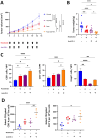HIF-PH inhibitors induce pseudohypoxia in T cells and suppress the growth of microsatellite stable colorectal cancer by enhancing antitumor immune responses
- PMID: 40343532
- PMCID: PMC12064516
- DOI: 10.1007/s00262-025-04067-3
HIF-PH inhibitors induce pseudohypoxia in T cells and suppress the growth of microsatellite stable colorectal cancer by enhancing antitumor immune responses
Abstract
Background: Recent studies have revealed that CD8+ T cells can be activated via genetic upregulation of HIF-1α, thereby augmenting antitumor effector functions. HIF-1α upregulation can be attained by inhibiting HIF-prolyl hydroxylase (HIF-PH) under normoxic conditions, termed pseudohypoxia. This study investigated whether pseudohypoxia induced by HIF-PH inhibitors suppresses Microsatellite stable (MSS) colorectal cancer (CRC) by affecting tumor immune response.
Methods: The HIF-PH inhibitors Roxadustat and Vadadustat were utilized in this study. In vitro, we assessed the effects of HIF-PH inhibitors on human and murine colon cancer cell lines (SW480, HT29, Colon26) and murine T cells. In vivo experiments were performed with mice bearing Colon26 tumors to evaluate the effect of these inhibitors on tumor immune responses. Tumor and spleen samples were analyzed using immunohistochemistry, RT-qPCR, and flow cytometry to elucidate potential mechanisms.
Results: HIF-PH inhibitors demonstrated antitumor effects in vivo but not in vitro. These inhibitors enhanced the tumor immune response by increasing the infiltration of CD8+ and CD4+ tumor-infiltrating lymphocytes (TILs). HIF-PH inhibitors induced IL-2 production in splenic and intratumoral CD4+ T cells, promoting T cell proliferation, differentiation, and immune responses. Roxadustat synergistically enhanced the efficacy of anti-PD-1 antibody for MSS cancer by increasing the recruitment of TILs and augmenting effector-like CD8+ T cells.
Conclusion: Pseudohypoxia induced by HIF-PH inhibitors activates antitumor immune responses, at least in part, through the induction of IL-2 secretion from CD4+ T cells in the spleen and tumor microenvironment, thereby enhancing immune efficacy against MSS CRC.
Keywords: Colorectal cancer; Hypoxia-inducible factor; Immune checkpoint inhibitors; Microsatellite stable.
© 2025. The Author(s).
Conflict of interest statement
Declarations. Conflict of interest: The authors declare no competing interests. Ethical approval: All experiments involving animals were conducted according to the ethical policies and procedures approved by The Animal Care and Use Committee of Okayama University (Approved No. OKU-2021900, OKU- 2022723, OKU- 2022879, OKU- 2023535). Consent for publication: Not applicable.
Figures





References
-
- Mortezaee K, Majidpoor J, Kharazinejad E (2023) The impact of hypoxia on tumor-mediated bypassing anti-PD-(L)1 therapy. Biomed Pharmacother 162:114646 - PubMed
MeSH terms
Substances
Grants and funding
LinkOut - more resources
Full Text Sources
Medical
Research Materials

